(1)
The negative sign is generally changed by considering the image projected between the viewing point and the object (Fig. 1).
In the pinhole assumption, the complex dioptric lens system is substituted by an ideal single lens, infinitesimally thin, thus the optical system agrees with the following assumptions [15]:
Other assumed hypotheses, adopted when dealing with digital images are:
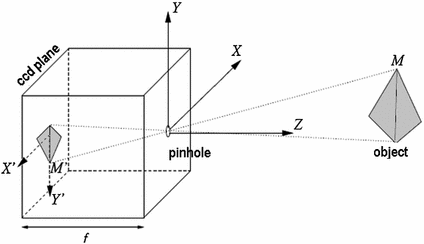
all parallel light rays are concentrated on the focus;
no refraction is induced to all rays passing through the lens center;
all non-centered rays are deviated in correspondence of the middle plane.
the optical axis is perfectly orthogonal to the sensor plane and centered on it;
the sensor gauge is organized by a two perfectly orthogonal cell disposition.

Fig. 1
Scheme of pinhole camera view
2.1 Identification of Grid Images
In this section we assume that the image is simply constituted by a regular square grid. In the next section the association of a grid to a general image is discussed. Figure 2 shows the projection of a simple square on the CCD plane that is reversed, as usually. The geometry projected on the plane is given by the four vectors connecting the observation point to the square corners.
Once the image is digitally acquired, each vector v associated to a point is known in its direction, while its magnitude remains unknown. All unknowns are represented by the moduli associated to the respective vectors. According to this logic, all vectors U are computed as differences of vectors V (Fig. 2). In the following, the vectors V will be addressed making use of respective unit vectors:  .
.
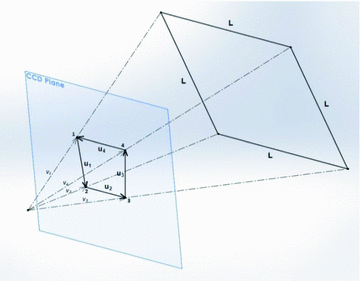
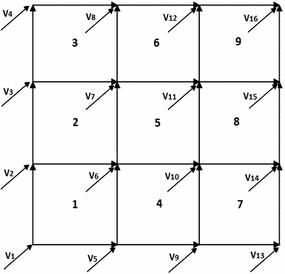
 .
.
Fig. 2
Vectors identifying the positioning of element nodes

Fig. 3
Nomenclature of a  grid
grid
 grid
gridMaking reference to the  grid represented in Fig. 3, the first element gives the following equations:
grid represented in Fig. 3, the first element gives the following equations:
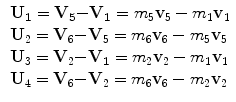
Being the grid formed by equal squares, several conditions can be imposed to each of them – note that not all of them are independent – represented in Table 1.
 grid represented in Fig. 3, the first element gives the following equations:
grid represented in Fig. 3, the first element gives the following equations:
(2)
Table 1
Vector and scalar conditions for a square grid
Geom. condition | Vector eq. | Number of scalar eqs |
|---|---|---|
 |  | 3 |
 |  | 3 |
 |  | 1 |
 |  | 1 |
 |  | 1 |
 |  | 1 |
 |  | 1 |
 |  | 1 |
 |  | 1 |
 |  | 1 |
The equations given in the previous Table 1 generates, using the modules as the unknowns, the following 14 equations (first two are vector equations):


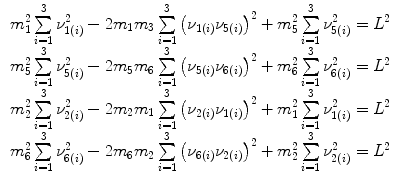
All above equations give a non-linear (quadratic) system of equations where the unknowns are vector magnitudes. If one considers all possible combinations of products of unknowns as unknowns themselves, they turn to be 10 for a single element, with 14 equations each. As an example, for the element n. 1 of Fig. 3, the 10 unknowns are listed in Table 2.

(3)

(4)

(5)
Table 2
List of unknowns produced by a single element
Unknowns | |||
|---|---|---|---|
1 |  | 6 |  |
2 |  | 7 |  |
3 |  | 8 |  |
4 |  | 9 |  |
5 |  | 10 |  |
The full system of equations is therefore over-determined and the solution can be found solving all the quadratic unknowns involved. After the full solution, each vector magnitude is computed by the root square of the quadratic unknowns. Furthermore, the mixed product of the unknowns can be used to check the accuracy of the solution gained.
2.2 Virtual Image Embedded on a Picture
If an image is present on a surface, this can be associated to a virtual grid. The point is to guarantee that the grid follows the changes of the image, due to movements of the surface that can be considered as a combination of rigid and deformable displacements.
This can be accomplished by considering the grid as a mesh of bilinear finite elements, whose movements guarantee the continuity of the surface. Each element contains a part of the initially flat image; this information is maintained in a natural coordinate system as shown in Fig. 4.
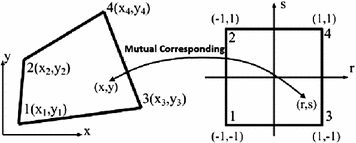

Fig. 4
Physical/Natural coordinate systems
Such reference approach is particularly suitable to compare elements that are initially irregular or become irregular due to large displacements on the image. Therefore, each sub-image is interpolated though a cubic spline approach. By this procedure, each element is always square-represented and keeps the same image content. In Fig. 5 is shown an example of how interpolation deforms the image.
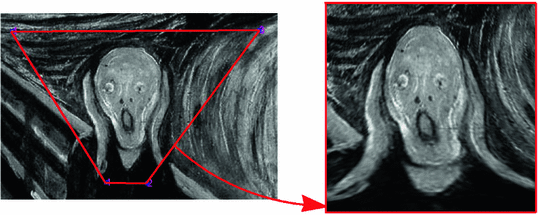

Fig. 5
Change from physical to natural coordinates
2.3 Results on Out of Plane Deformation
The data here presented, apart the very next subsection, refers to all effective pictures taken with a focal distance equal to 29 mm, corresponding to a printed paper positioned at 1500 mm from the ideal lens center. All images have been obtained with an aperture equal to 1/8 to increase overall focus depth.
2.3.1 Test of the Procedure on Exact Grids
The theoretical correctness of the procedure presented has first of all been investigated through the application on a simulated grid (no pictures does effectively exist) that has been deformed applying one or two finite curvatures. We can see that the reconstruction is perfectly accurate (no digital error on pixel definitions is present since pixel positions are recorded with 12 digit precision) only if the local orientation of the grid causes a single curvature change  . It is interesting to highlight that the application of a small noise (1 % of the diagonal length of a single element) reduces considerably the precision if the results are very accurate, but does not appreciably changes the behavior if discrepancies are already encountered when data are not affected by noise.
. It is interesting to highlight that the application of a small noise (1 % of the diagonal length of a single element) reduces considerably the precision if the results are very accurate, but does not appreciably changes the behavior if discrepancies are already encountered when data are not affected by noise.
 . It is interesting to highlight that the application of a small noise (1 % of the diagonal length of a single element) reduces considerably the precision if the results are very accurate, but does not appreciably changes the behavior if discrepancies are already encountered when data are not affected by noise.
. It is interesting to highlight that the application of a small noise (1 % of the diagonal length of a single element) reduces considerably the precision if the results are very accurate, but does not appreciably changes the behavior if discrepancies are already encountered when data are not affected by noise.From the above reasons, it is clear that the assumption of square grid to maintain its shape is very strong, difficult to obtain when double curvature are present. This means that the size of the elements of the grid should be taken as small as the curvature increases. As a matter of fact, the last row in Table 3 shows much better results in this case, as expected (double curvature keeping the same equivalent value than single curvature case).
Table 3
Noise effect on accuracy for various curvatures
No noise (%) | Added noise (%) | |
|---|---|---|
Plane grid |  1e-10 1e-10 | 4.06 |
Single curvature |  1e-10 1e-10 | 4.87 |
Double curvature | 23.13 | 24.21 |
D.curv. refined el. | 13.61 | 15.93 |
2.3.2 Tests on Pictures of Printed Grids
The grid is printed on a sheet of paper that is first photographed in a plane orthogonal to the focal axis, and the second picture considers the sheet deformed in various ways, such as the one shown in Fig. 6.
Four cases are here presented; (i) it concerns a  rigid rotation of the paper on a vertical axis as to generate a prospective view; (ii) it regards a simple half-fold oriented as the vertical axis in the center, and folded at a corner; (iii) the paper leaned on a cylinder (diameter = 450 mm) with a vertical axis; (iv) the paper applied on the same cylinder with the sheet base inclined of
rigid rotation of the paper on a vertical axis as to generate a prospective view; (ii) it regards a simple half-fold oriented as the vertical axis in the center, and folded at a corner; (iii) the paper leaned on a cylinder (diameter = 450 mm) with a vertical axis; (iv) the paper applied on the same cylinder with the sheet base inclined of  .
.
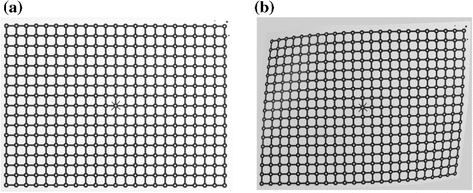
 rigid rotation of the paper on a vertical axis as to generate a prospective view; (ii) it regards a simple half-fold oriented as the vertical axis in the center, and folded at a corner; (iii) the paper leaned on a cylinder (diameter = 450 mm) with a vertical axis; (iv) the paper applied on the same cylinder with the sheet base inclined of
rigid rotation of the paper on a vertical axis as to generate a prospective view; (ii) it regards a simple half-fold oriented as the vertical axis in the center, and folded at a corner; (iii) the paper leaned on a cylinder (diameter = 450 mm) with a vertical axis; (iv) the paper applied on the same cylinder with the sheet base inclined of  .
.
Fig. 6
Digital pictures of the printed grid, a before and b after off-plane deformation




